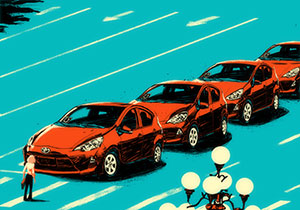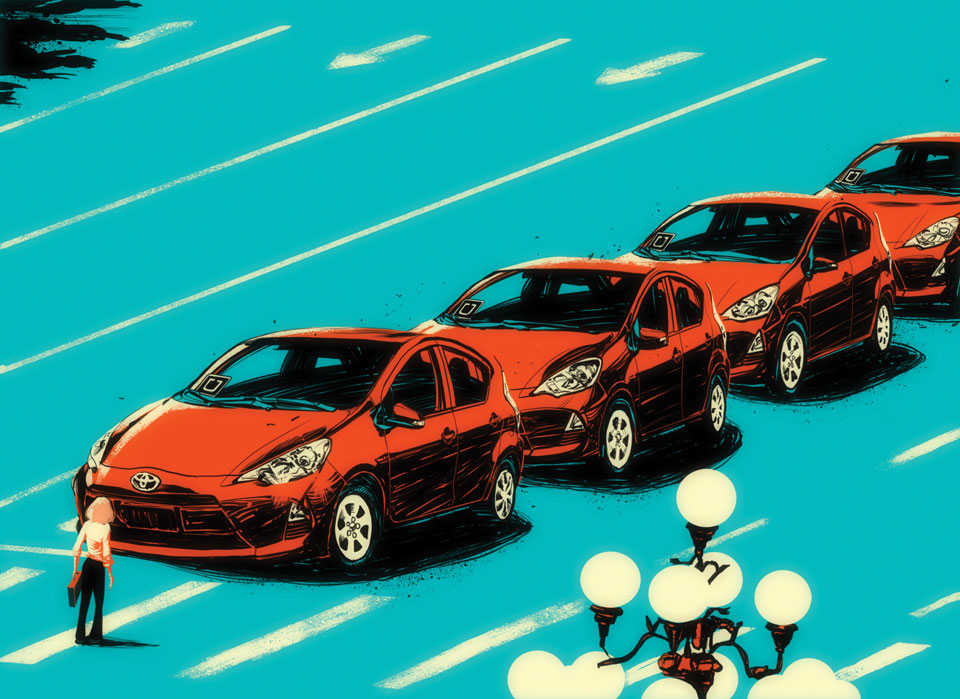If you drive out to visit Disney’s Epcot center in Orlando, Florida, you will arrive at one of the biggest parking lots in America. With room for 12,000 cars, it sprawls out over 7 million square feet—about the size of 122 football fields. If you look at the lot on Google Maps, you realize that it’s nearly the size of Epcot center itself. Disney built one Epcot to hold the visitors. Then it built another to hold the cars.
Disney isn’t alone in its expansive approach to parking. Parking is, after all, what cars do most of the time: The average automobile spends 95 percent of its time sitting in place. People buy cars because they need to move around, but the amount of time they actually do move around is tiny. So the cars are parked, and in multiple spaces: A car owner needs a spot near home, but also spots near other places he or she might go—the office, a shopping mall, Epcot.
A 2011 study at the University of California-Berkeley found that the United States has somewhere close to a billion parking spots. Since there are only 253 million passenger cars and light trucks in the country, that means we have roughly four times more parking spaces than vehicles. If you totaled up all the area devoted to parking, it’d be roughly 6,500 square miles, bigger than Connecticut.
Social critics often complain that the interstate highway system deformed the United States by encouraging sprawl. But the metastasizing of parking has had equally profound effects. On an aesthetic level, it makes cities grimly ugly. Economically, it is expensive to build. A study by the Sightline Institute found that at least 15 percent of the price of rent in Seattle stemmed from developers’ cost of building parking.

Those costs are passed on to tenants whether they own a car or not (on top of any per space fee the landlord charges)—padding rent by an average of $246 a month in Seattle and $225 nationwide.
And worst of all may be the emissions that parking causes. Studies have found that anywhere from about 30 to 60 percent of the cars you see driving around a downtown core are just circling, looking for an open space to claim. (An IBM survey found that worldwide, urban drivers spend an average of 20 minutes per trip looking for parking.) When Donald Shoup, an urban-planning professor at the University of California-Los Angeles, examined just one small business area near his university—Westwood Village—he found that “cruising” for parking, as he dubs it, burns 47,000 gallons of gas and generates 730 tons of carbon dioxide a year. What’s more, all that asphalt traps heat and raises the temperature of cities during the summer. Environmentally, aesthetically, and economically, parking is a mess.
But for the first time in history, urban experts are excited about parking—because they can see the end in sight.
We are, they say, on the cusp of a new era, when cities can begin dramatically reducing the amount of parking spaces they offer. This shift is being driven by a one-two punch of social and technological change. On the social side, people are increasingly opting to live in urban centers, where they don’t need—or want—to own a car. They’re ride-sharing or using public transit instead.
And technologically, we’re seeing the rapid emergence of self-driving cars. Google’s models have traveled more than a million miles with almost no accidents, and experts expect that fully autonomous vehicles will hit the consumer market as early as a decade from now. Indeed, car technology is advancing so rapidly that it’s causing legitimate economic concerns. Already, companies like Uber and Lyft are under fire for treating drivers as independent contractors, with far fewer rights and benefits than employees (see “Road Warrior“). And that disruption is nothing compared with what will happen once cars can drive themselves; millions of taxi, delivery, and long-haul trucking jobs that traditionally have gone to new immigrants and low-education workers could vanish in a few years. Labor activists and economists are understandably alarmed at the prospect.
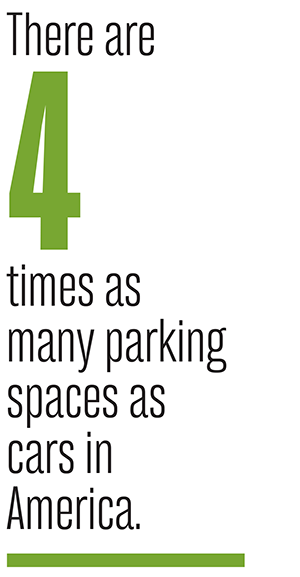
But at the level of urban design and the environment, self-driving cars could produce huge benefits. After all, if cars can drive themselves, fleets of them could scurry around picking people up and dropping them off, working with sleek, robotic efficiency. With perfect computerized knowledge of where potential riders were, they could pick up several people heading the same way, optimizing ride-sharing on the fly. One study suggests a single self-driving car could replace up to 12 regular vehicles. Indeed, many urbanists predict that fleets of robocars could become so reliable that many, many people would choose not to own automobiles, causing the amount of parking needed to drop through the floor.
“Parking has been this sacred cow that we couldn’t touch—and now we can touch it,” says Gabe Klein, who has headed the transportation departments in Chicago and Washington, DC. He sees enormous potential—all that paved-over space suddenly freed up for houses and schools, plazas and playgrounds, or just about anything. “All that parking could go away, and then what happens?” he asks. “You unlock a tremendous amount of value.”
America began its love affair with parking in the 1940s and ’50s, when car use exploded. Panicked cities realized they would soon run out of curb space, but they didn’t want to discourage car ownership or build enough public transit. So instead they passed minimum parking requirements: If a developer wanted to erect a new office or apartment building, it had to build parking. For residences, typically two spots per household are required. And in general, cities calculated the highest peak amount of parking a location might need and demanded that developers build it.
Way back in the 1960s, UCLA’s Shoup became alarmed by the massive growth of parking. As he saw it, the problem was that in most people’s minds, the spaces seemed to be “free.” When developers are forced to build parking, the cost is folded into the purchase price, be it a home, an office, or a restaurant. And when people don’t pay to park at the curb (only a tiny fraction of curbside spots in the United States are metered), it’s the city that pays to build and maintain that spot. These costs are passed down to consumers and taxpayers, but since they’re never itemized, they’re easy to ignore. In my neighborhood in Brooklyn, for example, housing prices are sky-high, but the city doesn’t charge me to park on the street. When I tell this to Shoup, he points out that if they did charge me, the odds are high that I’d never have bought my car. When a city provides free parking, it’s also economically unfair, since it’s a subsidy available only to those who are wealthy enough to own cars.
“Parking is wildly mismanaged—it’s probably our most inefficient use of resources in many ways,” Shoup tells me. Indeed, minimum parking requirements usually force developers to build more parking than the market actually calls for. Sightline found that in greater Seattle, 37 percent of residential lots are empty at night—precisely when you’d expect residential parking spaces to be most used.
The deep irony is that cities rarely require developers to construct enough affordable housing, but they pass strict laws making sure vehicles can be adequately housed. “We don’t force [developers] to build the right number of bedrooms for people! We just force them to build the right number of bedrooms for cars,” says Jeffrey Tumlin, the principal and director of strategy for Nelson Nygaard, a parking consultancy.
To be fair to politicians, there’s a long history of people freaking out if parking isn’t plentiful. “Thinking about parking seems to take place in the reptilian cortex, the most primitive part of the brain responsible for making snap decisions about urgent fight-or-flight choices, such as how to avoid being eaten,” as Shoup dryly wrote in his 2005 book, The High Cost of Free Parking.
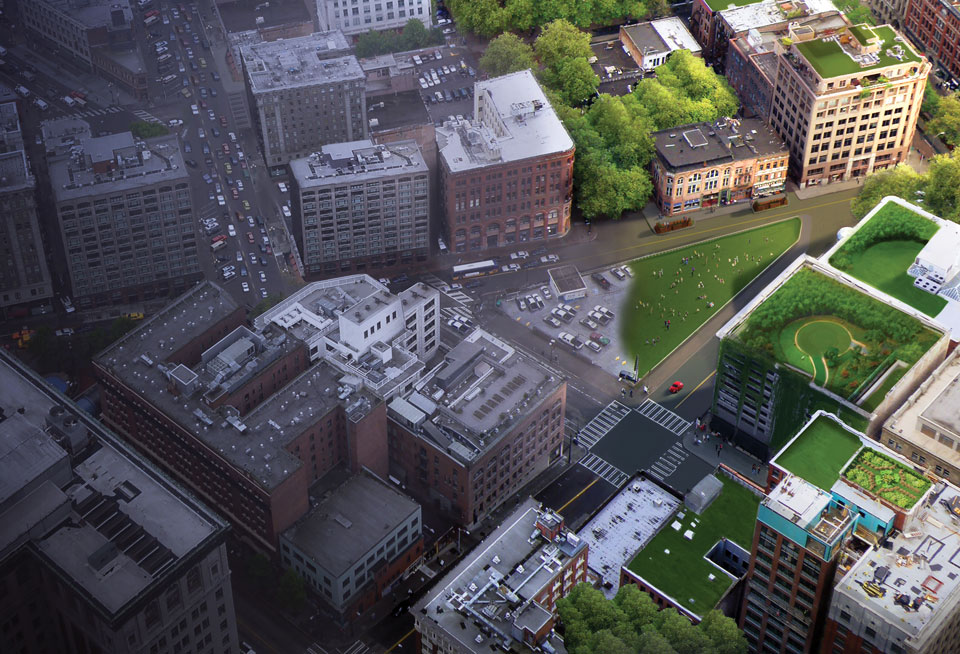
Ultimately, he notes, parking is a self-reinforcing problem. Cities trained people to expect that parking would be plentiful and free, which encouraged them to drive everywhere—which made them demand more parking. Decades of perverse incentives cemented the automobile as the main way people get around. As the Census Bureau reported in 2005, fully 76.4 percent of US workers who lived in the same city where they worked commuted to their jobs in a car, by themselves. Only 7.8 percent of them commuted by public transit. Parking, urban reformers fretted, seemed like an intractable problem.
AT LEAST, THAT’S how the picture looked 10 years ago. But then something strange happened to our relationship with cars.
Jeff Kenworthy is a professor of sustainability at Curtin University in Australia, and for decades he has been collecting data on how people travel in major industrialized cities around the world. He’s found that the pace at which people increase their use of cars has been slowing. In the ’60s, car use grew by 42 percent. In the ’80s, it grew by less—only 23 percent. Then from 1995 to 2005, it went up by only 5 percent. In some cities car use actually declined, including London (down 1.2 percent), Atlanta (10.1 percent), and Houston (15.2 percent). Kenworthy says many cities are reaching “peak car use,” and it’s all downhill from here.
“The dominance of the car,” he says, “is on the wane in many places.”
Why? It’s partly the price of gas, which rose dramatically in the early 2000s and has in many parts of the world stayed high since then. (Car insurance is historically high too.) But Kenworthy suspects it is also related to a concept known as the “Marchetti Wall.” Back in 1994, the Italian physicist Cesare Marchetti observed that throughout history—going back to ancient Rome—the majority of people disliked commuting more than one hour to work. If you’re faced with a longer commute, you hit the Wall and rearrange your life, finding a new, more local job or moving closer to the office. In the 1990s and early 2000s, not only did use of public transit grow, but Kenworthy found that cities worldwide were becoming denser, in part because millennials weren’t decamping for the suburbs (like their boomer parents did), and because seniors were moving back to urban cores, to enjoy the walkable life. As a society, we slammed into the Marchetti Wall and backed away.
True, this trend isn’t necessarily set in stone. While the number of vehicle miles traveled per capita in the United States began declining in 2005, it began rising again in 2014. The dip might have been a result of the Great Recession and $4-per-gallon gas, says Constantine Samaras, a civil and environmental engineer at Carnegie Mellon University. The price of gas in the United States has since gone down, and “when the price is cheap, people are going to drive more.”
But many experts argue that the urbanizing trend is likely to accelerate because millennials are a Marchetti generation—they’re increasingly turning against the car. Research by the Frontier Group, a think tank that often publishes work on energy and transportation, found that the average annual number of miles driven by American 16- to 34-year-olds dropped 23 percent between 2001 and 2009, a pretty stunning fall. Meanwhile, millennials took 24 percent more bike rides and used more public transit. Indeed, they’re much less likely than previous generations to even be able to drive: In 1983, some 87.3 percent of 19-year-olds nationwide had a driver’s license. By 2010, only 69.5 percent of them did. And while you might suspect that the recession was at play, rates of driving are down even among young adults with high-paying jobs.
When millennials are polled, they’re much more likely than their elders to say they try to actively minimize driving to avoid causing environmental damage. They’re buying far fewer cars than their forebears did, which worries carmakers. Toyota USA President Jim Lentz said in a speech last year, “We have to face the growing reality that today young people don’t seem to be as interested in cars as previous generations.”
THERE IS ONE trend of mobility that young people have embraced, though: On-demand car services like Uber and Lyft.
A year ago, Uber reported that its drivers were making 1 million trips per day; this past summer, the company told prospective investors that it was growing 300 percent year over year. Fully 70 percent of Uber’s customers are under the age of 34, and 56 percent of them live in cities, as a survey by the market research firm Global Web Index found. Ride-hailing has big implications for weaning cities off their addiction to parking. The millennial generation is learning that it can have a car without needing to own or ever park one.
What’s more, Uber is seeing especially rapid growth in its ride-sharing offering, Uber Pool, which matches travelers heading to roughly the same destination. In exchange for sharing a ride, the fare is at least 25 percent cheaper than a regular Uber fare. The company introduced the service in San Francisco a year ago, and already nearly 50 percent of all Uber rides in the city are pooled.
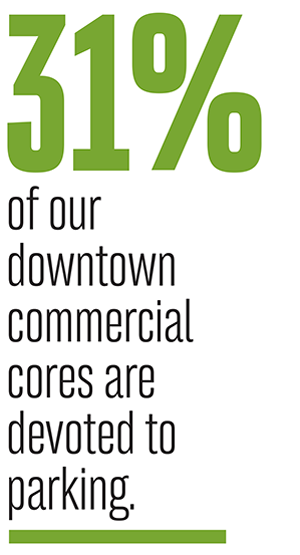
This fact stuns even Uber itself. “The adoption of ride-sharing is larger than anybody anticipated. The market is massive,” says David Plouffe, the former Obama campaign manager who is now Uber’s chief adviser and a board member, during an interview at the company’s shiny headquarters in downtown San Francisco. “I don’t think anyone who was around in the beginning suggested that the market would be this big. I mean, we have a good service, but clearly this is married up with how people want to live.”
Uber, he says, is now launching a service aimed at ride-sharing for daily commutes. “So, I’m getting ready to go to work. I put my coffee mug in the sink. I turn on the app. I pick up my keys. Somebody three blocks away says, ‘I’m going the same way,'” he says.
Carpooling, of course, has been touted for decades as a way to use cars more efficiently. But it never took off because it suffered from an information problem: There was no way to coordinate rides on the fly, no way to know whether someone four blocks away was heading in the same direction as you, right this instant. Safer just to drive yourself, right? And this gave birth to a welter of personal choices that seemed perfectly reasonable individually, but that together created a massive environmental and urban land use problem—with many of us heading off to work in the same direction and with cars that contained, statistically, only 1.13 people each.
That information problem is now gone. The smartphone has solved it. Equipped with GPS and mobile data, the mobile phone may ruin our concentration and erode our privacy at every turn, but it’s remarkably good at one task: on-the-fly coordination. If the trend toward ride-sharing keeps accelerating, how might that change traffic and parking? When a group of MIT scientists crunched data on Boston-area commuting patterns, they found that if 50 percent of drivers shifted over to ride-sharing, it would reduce traffic congestion by 37 percent and decrease the number of vehicles on the road by 19 percent.
Tumlin, the parking consultant, is struck by the shift in the zeitgeist. He’s 46 and says that “my generation was the last generation to believe that owning our own car would bring us freedom, autonomy, social status, sex.” For today’s young people, the mobile phone is a much more potent technology of autonomy and social status—and, in a neat twist, you can’t use your phone while you’re driving. They are rival activities, and the phone is winning. People want access to a car, but don’t feel a need to own one, just as they’ve increasingly adopted streaming services instead of vinyl, CDs, or even MP3s.
“This conflation of auto ownership and personal identity,” Tumlin concludes, “is permanently broken.”
WHEN THE GOOGLE self-driving car first pulled out into a busy intersection, with convertibles racing past us, I stole a look over at the driving wheel. It was turning by itself, as if a ghost were piloting the vehicle. It was an unnerving sight, though the Google engineers riding along with me were by now quite blasé: These cars have already driven a total of 1.2 million miles and have only been in a tiny number of accidents. The computer guidance system, said the engineer sitting in the driver’s seat—his hands folded in his lap—is a very cautious driver.
“Almost like a new person who’s driving for the first month or so,” he added. These cars can also sense far more than humans can. Another engineer riding shotgun held a laptop showing how our car “saw” the road with its laser, radar, and camera vision: The screen looked like the wireframe of a video game, with yellow boxes for pedestrians, red boxes for cyclists, and purple and green ones for other vehicles. The car could see not just what was ahead of us, but far off to the sides and behind us too.
“That’s what makes computers more fun, that they can detect a million things at one time, whereas your average driver is probably only focused on that one thing,” the engineer said with a grin. As if to prove the point, the car abruptly slowed down: It had detected a woman to our right drifting slightly into our lane.
Ten years ago, self-driving car prototypes could barely drive 10 miles across a relatively uncluttered desert. Now they’re expertly weaving through traffic in Silicon Valley, Austin, and Pittsburgh. “The rate of progress,” marveled the engineer, “is mind-blowing.” They dropped me off at Google’s headquarters, where I wandered up to a rooftop parking lot. There, Google’s latest prototype—so new that journalists aren’t allowed to ride in it—was tooling around: a cute, egg-shaped little pod that was about as big as a Smart Car, except it didn’t even have a steering wheel.
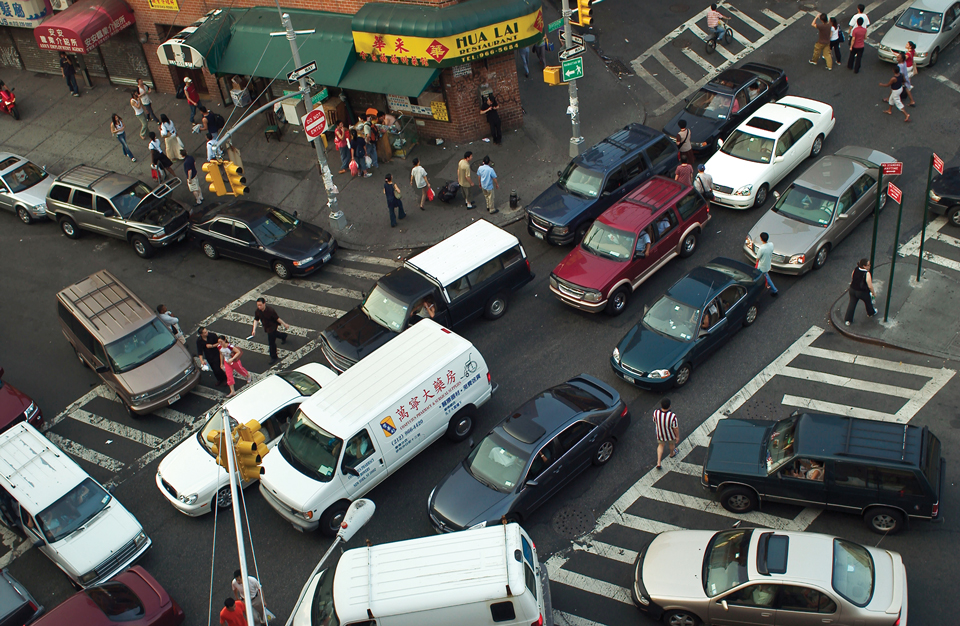
How will self-driving cars change the way we get around? Many urban experts think the future of those egg-shaped cars isn’t in private ownership. It’s in fleet deployment. Certainly, that’s what Uber believes; last year it set up a research lab in Pittsburgh specifically to develop its own self-driving cars. In the not-too-far-off future, CEO Travis Kalanick predicts, you could call for an Uber car and a self-driving robocar could zip up to whisk you away.
Unlike human drivers, robot cars wouldn’t need to look up the route or the location of the nearest passenger, so they wouldn’t waste time dithering, as humans do. Robot cars could also drive much more closely to one another, packing far more vehicles onto a street. (Computer scientist Peter Stone even created software that would let robot cars do away with traffic lights; instead of stopping at an intersection, they would simply weave around one another, navigating street corners nearly 10 times faster than cars do today.)
What’s more, they’d never need to park. At the University of Texas-Austin, Kara Kockelman—a professor of transportation engineering—modeled the impact of autonomous ride-sharing vehicles and found that each one could replace up to a dozen regular cars. The robocars could drive all day long, stopping only to refuel or for maintenance; at night, when there was less demand, they could drive out to a remote parking spot on the outskirts of town. The upshot, Kockelman figures, is that if you shifted the entire city to autonomous cars, it would need a staggering 90 percent less parking than it needs today. It’d be speedy travel: In Kockelman’s model, when people called for a car, one typically came along in about 20 seconds. It’d be profitable: When she spec’d out the cost of running an Uber-like fleet of robot cars, she calculated it would cost $70,000 to buy and deploy each vehicle, but that each would earn a 19 percent profit on investment every year. And rides would only be about $1 per mile, even if just a single passenger rode at a time—half as cheap as today’s typical Austin cab fare.
“You could make the fleet smaller,” she says, “and you can reduce parking in downtown.” The streets would still be busy—crowded, even—with vehicles whizzing to and fro. It’s just that they wouldn’t need to park. It would be the taxi-ization of nearly all human mobility.
A city run on shared autonomous cars would likely have a dramatically lower environmental footprint. That’s partly because you’d get rid of the “circling” that plagues urban traffic. But it’s also because high-tech cars would be new—and, given that they’ll probably emerge en masse about 10 years from now, they’d be electric. A model of city traffic published in Nature last July by Berkeley Lab scientist Jeffrey Greenblatt deduced that emissions would be 90 percent lower if cars were all autonomous and electric. And the truth is, it’s easier for a fleet of robot cars to go electric than it is for individual car owners to do so. If I owned an electric car, I’d constantly be at risk for “range anxiety”: the fear that my battery might die when I’m far from a charging station. But a robot fleet could optimize repowering, sending a car to pick up a traveler only when the car had enough juice to get to the traveler’s destination, and taking low-battery cars out of service to recharge as needed.
“You could conceivably imagine a world in which you don’t need to pave as much of the roadway,” says James Anderson, a behavioral scientist at RAND who co-authored a report on autonomous cars in 2014. “If they’re driving themselves, cars could precisely put themselves on four-meter-wide bits of pavement,” leaving the rest of the road to some other purpose or surface, maybe grass. “You can imagine fairly utopian, far-off visions.”
We won’t know what’s truly possible until there are lots of autonomous vehicles on the road. For all the success that Google, Stanford, and Carnegie Mellon University have had with their robot cars, they’ve mostly been driven in mild climates. Nobody has figured out how to tackle snow, which tends to confuse today’s computer vision systems. It’s probably solvable, but precisely when—or when governments will be satisfied enough of self-driving cars’ safety to approve them for sale—is anybody’s guess.
But you don’t need fully autonomous cars to get big reductions in parking. Already some cars can parallel park themselves. Carmakers could soon produce vehicles that you drive yourself but that, once you’re at a parking lot, you send off to find a space by themselves. Since nobody would need to get in or out of them after they parked, they could position themselves as snugly together as Tetris bricks, fitting far more cars into our existing parking lots and garages. Achieve even this small feat of self-driving, and it could be possible to never build another piece of parking, says Samaras, the Carnegie Mellon engineer.
Some urban thinkers told me that 15 years from now, autonomous vehicles will have erased the need for up to 90 percent of our current lots. “There is more parking today in American cities than they will ever, ever need,” Tumlin says. It’ll vanish as human driving vanishes.
“Who will be the last human driver?” asks Samaras. “It’ll probably be our grandkids.”
WHAT WOULD A CITY look like if it suddenly needed 90 percent less parking?
A few cities have experimented with reclaiming road space. One of the biggest such projects was in Seoul, South Korea, in the early 2000s, when the municipal government tore up a 3.5-mile elevated highway that had covered the Cheonggyecheon River and transformed it into a public park. The effects on the city were immediate: In addition to encouraging a surge in tourism, the park cooled the surrounding area by 9 degrees Fahrenheit during the summer.
“Now they have this incredible green corridor with tons of space and hundreds of thousands of people using it,” says Kenworthy. There had been 120,000 cars a day flowing through the area, and opponents of the project had claimed that all these cars would cram onto side streets instead. But car use went down. We often believe traffic is like a liquid; prevent it from going down one road, and it’ll just flow down a nearby one. But in reality, Kenworthy says, traffic is more like a gas: “A gas compresses or expands based on how much space you give it.”
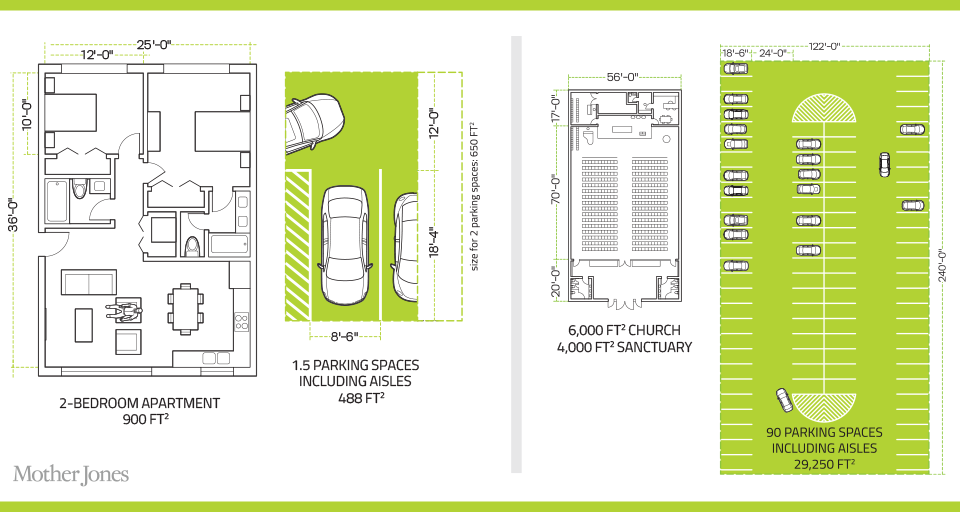
New York City has seen similar experiments. Ex-Mayor Mike Bloomberg closed down several blocks of Times Square, turning them into well-trafficked pedestrian hangouts. The most famous reclaimed space is Manhattan’s High Line, once a dilapidated elevated railway and now a verdant park that drew 6.2 million visitors in 2014 (2 million of whom were locals) and hosts live events. “It’s a park, it’s a cultural institution, it’s a plaza, all put together,” says Robert Hammond, who spearheaded the restoration project and now runs the nonprofit that tends it. He suspects the future of public parks is these sorts of “hybrid” spaces, built on reclaimed urban space.
When land in a city suddenly becomes freed up for new uses, it’s called “infill.” The downside of our love affair with cars is that on average we’ve asphalted over 31 percent of our commercial downtown cores with parking. But the upside, Shoup tells me, is massive potential infill. If we wean ourselves off the need to store cars, spots and lots could be converted into parks, schools, hospitals, housing. Better yet, it’s property that is precisely where you’d want new development: downtown, inherently walkable. “The upside of the mess we’ve made,” Shoup says, “is that we have a lot of land.”
Take New York City, where there are roughly 102,000 public parking spaces below 60th Street—taking up roughly 18.4 million square feet, a space equal to about half of Central Park.
“San Francisco is going bananas for new housing, and Manhattan is always looking for space, and here we have this sitting in front of us,” Samaras says. “That’s what autonomous vehicles can do.”
THERE ARE SOME big speed bumps on the road to a low-parking future, though. That’s because most of these rosy projections assume self-driving cars are likely to be deployed en masse by ride-sharing firms that would use them with deep efficiency, offering such convenience and cheapness that we’d all ditch our personal vehicles.
But there’s another route the future might take. Shannon McDonald, an architect and historian of American parking, recently got a glimpse of it. She flew to Baltimore to visit her brother, who picked her up in his new car. It included several self-piloting features; he showed her how it wouldn’t let him steer accidentally into a neighboring lane on the highway, and when he got home, the car parallel parked itself. Such features might make self-driving cars so alluring that everyone wants one.
“What if they’re all privately owned? You’ve got a driverless vehicle, and maybe you don’t share it,” McDonald tells me. If her brother and sister-in-law had a fully self-driving car, maybe they’d decide to go to New York to see theater. It’s a crazy-long five-hour drive, but who cares? They could kick back. They would “ride all the way in and sleep in it all the way back,” she says. If you can read, watch TV, work and do email, or catch up on sleep while your car steers, the sting goes out of commuting.
In this version of the future, self-driving cars could smash through the Marchetti Wall. They would unlock what’s known as “induced demand”—prompting commutes of such lengths that they’d have been previously unfathomable. Or we might find people deciding they never need to park their cars because, hey, cars can circle on their own.
McDonald imagines a commuter going to work in his self-driving car: “Let’s say he gets to the office, he gets dropped off at the front door. And he tells the car to go find its cheapest parking.” Maybe it drives out to the far suburbs, to park for free on a side street. “He says, ‘Okay, just go have fun today! Go drive around! Come back and get me at five. Why not? It’s cheaper!'” The problem of cruising could morph into a Monty Pythonesque parody of modern life: a street clogged with traffic, but all the cars are empty. In economic terms, this is called a “rebound effect”: If you make something suddenly more efficient to do, people will do more of it.
Urban and traffic thinkers are divided about how serious these negative impacts could be. Many suspect the Marchetti Wall will remain in place. “We’re unmoved by these arguments,” says Berkeley Lab’s Greenblatt. “Because seriously, most people are not going to sit in a car for hours a day.” Others agree, pointing out that the generational shift away from owning a personal car isn’t likely to dim. Most experts I spoke to said governments should set policies that make fleet-based ride-sharing more appealing than individual car ownership. The main lever here is “congestion pricing”: A city could—as London already does—require drivers to pay extra fees to travel in the congested downtown areas unless they’re in ride-shared vehicles. Nearly every expert I spoke to advocated some version of congestion pricing to prevent a rebound effect.
Others pointed out that personal ownership might well blur with fleet ownership. If someone owned a self-driving car, she might opt to make money off it by having it drive off to work for a fleet when she’s at the office. Cities could also offer incentives to ride-sharing services that augment public transit, feeding people to major subway and rail lines. (This is already a trend: Uber reports that in some cities, one-third of its trips begin or end at a public-transit station.)
The bottom line is, if urban officials want to make sure these technologies benefit civic life, they need to start talking about them now. “If we want it to be sustainable, the city has to get involved in these services,” says Tom Radulovich, executive director of Livable City, a nonprofit transit group. Cities could deploy their own fleets of subsidized self-driving cars—the next generation of public transit—aiming them particularly at the mobility disabled and underserved and low-income areas, where residents often lack the credit cards required by ride-sharing apps. They could commission vans that could pool more people than a car, providing a nice midpoint between personal vehicle ownership and a bus.
If cities leave self-driving cars entirely to the private sector, they court risk. When the usage of public transit grows or shrinks, the city knows immediately, and can adapt to what the public is demanding. But companies like Lyft and Uber are opaque, releasing very little information about their usage. This is already making it hard for San Francisco to plan for the future: Figuring out where to develop public transit hinges on understanding how people are moving themselves around using private-sector means. “We don’t have the data to understand the market size and what’s happening to it,” says Timothy Papandreou, the city’s director of strategic planning and policy for SFMTA.
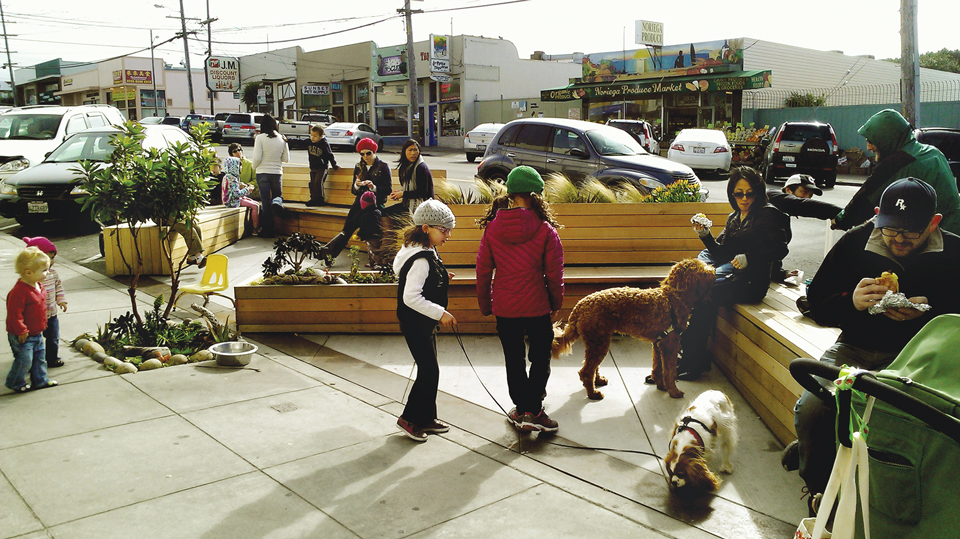
As Radulovich points out, there’s historical precedent for the government getting more deeply involved in regulating private ride-sharing. After all, today’s public transit started out as a hodgepodge of private systems—a bus line here, a streetcar there—that slowly merged into one large system. “Public transit went through this—it was venture funded, but then it became public.” That reverse privatization is unlikely to happen again, but cities could ensure the system serves civic needs by using carrots and sticks: incentivize people to use ride-sharing but require that ride-sharing firms share their data.
Gabe Klein argues that good deals can serve both the city and the private sector. When he ran the transportation system in Washington, DC, Klein—who’d previously worked for Zipcar—created a new policy: Zipcar would be allowed to park its cars for free in some curbside city spots. It was controversial: giving away a public resource to a private firm? But Klein argued that because a single Zipcar is used by many people and driven far more often than a regular single-owner car, each would take cars off the road. Klein also got DC to charge more for on-street parking, again nudging people away from owning private cars. In the ensuing years (which also saw the rise of the ride-sharing apps), DC saw 6 percent fewer registrations for cars, even as the population increased by 3 percent.
OBVIOUSLY, CITIES SHOULD get cracking on their plans for the self-driving future. But are there things they can do right now to reduce the amount of parking and driving?
Shoup recommends that cities apply something like Uber’s infamous surge pricing to parking: If a block tends to be full of parked cars at a particular time of day, the city should charge more, and if the demand is lower, it should charge less. The goal, Shoup says, is to price parking so that there are always one or two spots open on a block. Achieve that, and presto: A city could get rid of circling, since drivers could always quickly find a spot. Emissions and traffic would go down, while higher meter fees would encourage use of public transit.
Would dynamic pricing actually work?
In 2011, San Francisco decided to find out. In several areas of downtown, it set up new high-tech meters and sensors in the ground that told the city how busy these blocks and city parking lots were from morning to noon, from noon to 3 p.m., and from 3 p.m. to the evening. Every few months, the city examined the data and adjusted the price for each time segment of each block or lot up or down. Over the next two years, the city shifted parking costs upward on 37 percent of the time segments per blocks or lots, while at another 37 percent, the prices dropped. (The price of the others fluctuated.) It turned out that the hottest demand for parking was between noon and 3 p.m.
The new pricing scheme had precisely the effect the city hoped it would. Blocks that were previously jammed all day now typically had one spot open. Overall, driving in the pilot areas went down by about 2,400 miles per day—and circling plummeted by 50 percent. That helped reduce greenhouse gas emissions by 30 percent. (In comparison, areas in the city that weren’t in this pilot study saw their emissions go down by only 6 percent.) Meanwhile, drivers reported that it took them 43 percent less time to find parking. And the program was even profitable: The city took in $3.3 million more at the meters, even as it lost $500,000 as parking citations decreased.
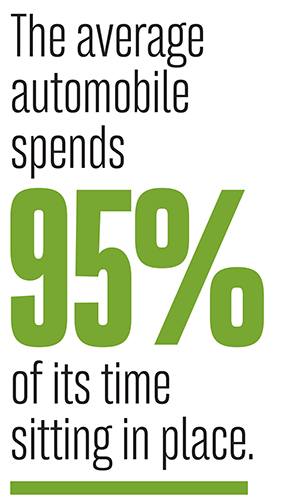
“Seeing the circling go down was one of the nicest findings,” said Tom Maguire, director of Sustainable Streets for the city’s Municipal Transportation Agency, when I visited him in his downtown office. “The circling hurts everybody: air quality, greenhouse gas, collisions, making the streets much less pleasant.” He was also happy to put some meat on Shoup’s arguments against free parking. “If there’s one takeaway, it’s that the theory is true: If you raise the price, you have a little less parking demand. Until we did something on the scale of almost the entire downtown of San Francisco plus seven other neighborhoods, I don’t think it had been proven that the theory was true.”
So far, alas, few cities are following San Francisco’s lead. People—especially merchants—tend to holler when a city starts charging for parking. Three years ago, Ellicott City, a historic town in Maryland, installed smart meters on its main drag, only to have so many merchants complain that the city soon tore them out.
Shoup thinks cities need to be politically savvy to get citizens on board. One way, he says, is to engineer the meters to provide a hyperlocal benefit—plow some of the profits a meter generates back into sprucing up the very street on which the meter sits. Ventura County in California installed smart meters that were connected by wifi to the city, and then used those meters to broadcast free wifi to locals. It was an immediate hit.
But the central policy that can discourage the growth of parking is to eliminate minimum parking requirements. Take Los Angeles, which used to force developers to build two parking spots for every new unit of housing, hampering redevelopment in the downtown core. In 1999, the city eased the rules, and in a short time, developers started renovating the old buildings, providing an average of only 1.3 parking spots per unit. Buyers didn’t care: They still bought the housing. The market, as Shoup observes, is willing to cope. Build less parking, and people will find other ways to get around.
A LOWER-PARKING FUTURE could be downright lovely, judging by a glimpse I recently got of it. I was walking through the Mission District of San Francisco when I came across a curious sight: two curbside parking spots that had been transformed into a tiny public “parklet.” Built out of huge, curved pieces of wood, it looked like a ship beached on the side of the road. Two young men sat on the benches having a business meeting. Across the street was another parklet, where thick desert vegetation—some clipped to resemble a triceratops—spilled out in front of a private residence.
Founded five years ago—and since emulated by cities ranging from London to Ames, Iowa—San Francisco’s parklet program allows a property owner or business to apply to transform their storefront parking spots into a wee little plaza. There are now scores of parklets throughout San Francisco, including a particularly fascinating cluster of nine between 20th and 24th streets on Valencia Street. As I toured the strip, it gave me a vision of how remarkably a city could evolve: Imagine if 90 percent of all curbside parking spots were turned into strips of public parks, filled with greenery, urban gardening, and people relaxing.
They are oddly peaceful places. A few blocks down the strip at another parklet with a rainwater catchment exhibit, I found Nicole Hubman, a 30-year-old who was sitting and reading, waiting for her yoga class across the street. It turns out that Hubman’s life is a study in the massive changes already underway in our relationship to driving. She used to live in Boston, where her commute was an hour and a half each day. She hit her own Marchetti Wall, and it made her miserable. So when she moved to San Francisco, she decided to get around on public transit.
“I hate driving,” she says. “I’m allergic to it.”
